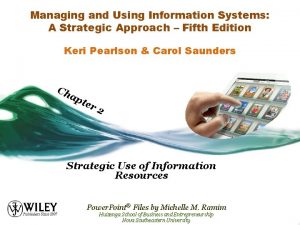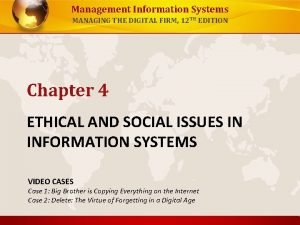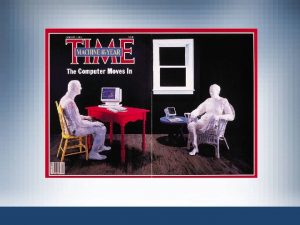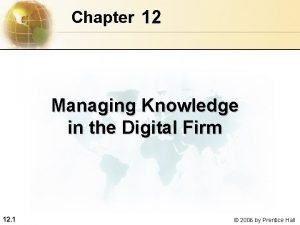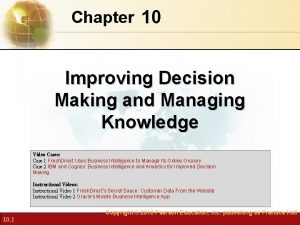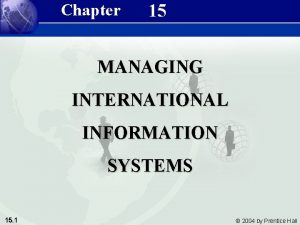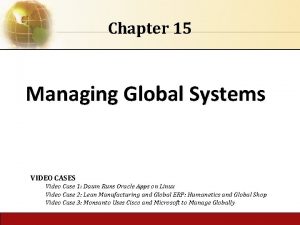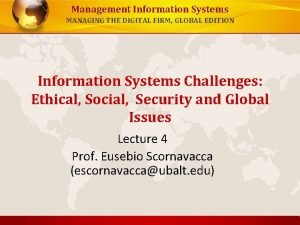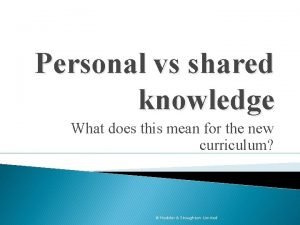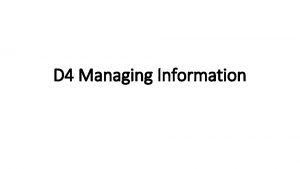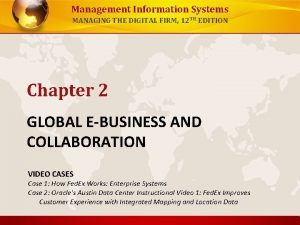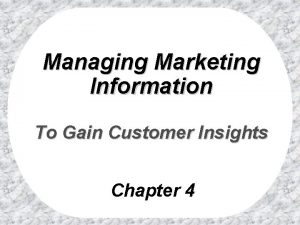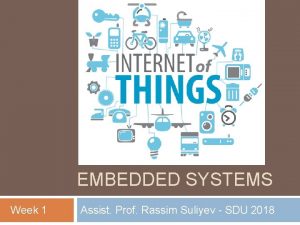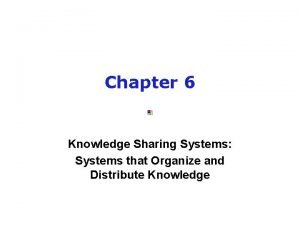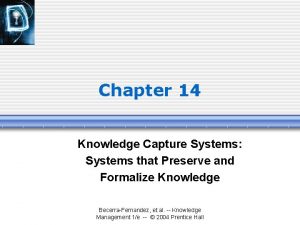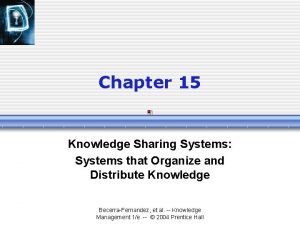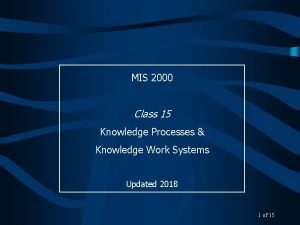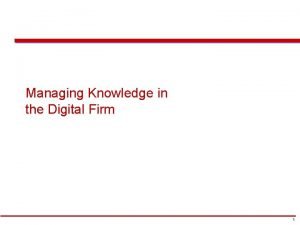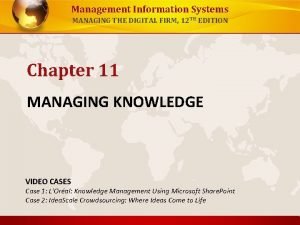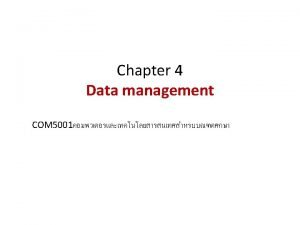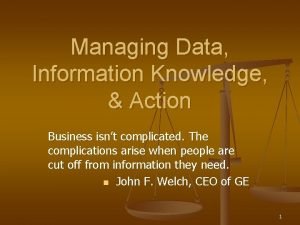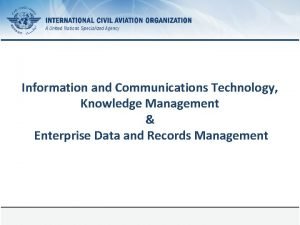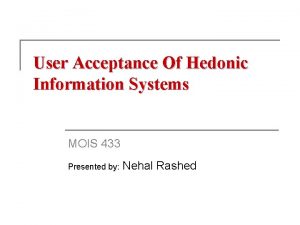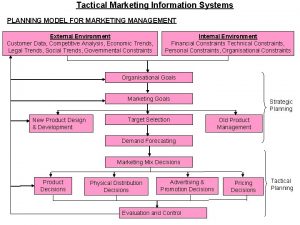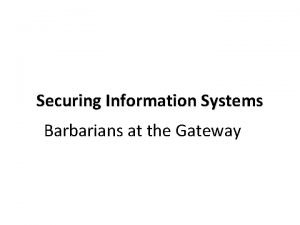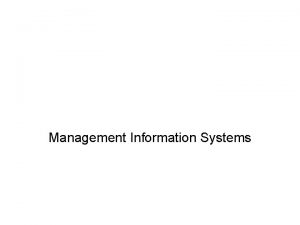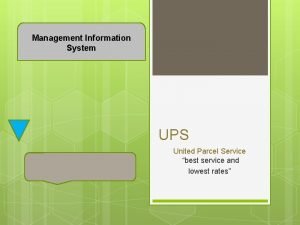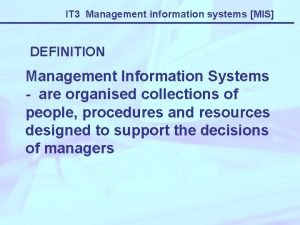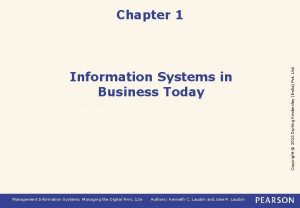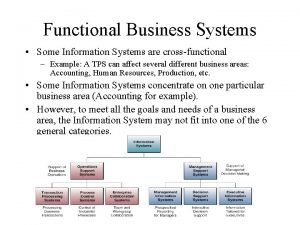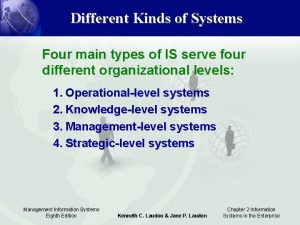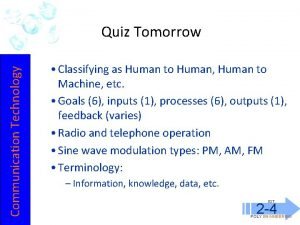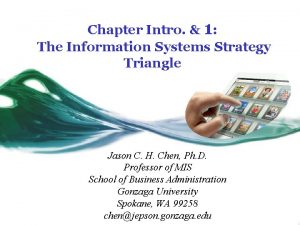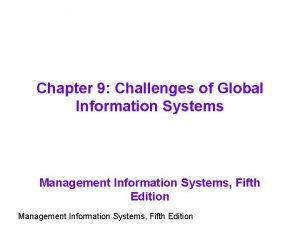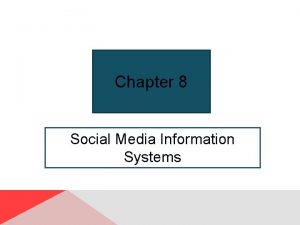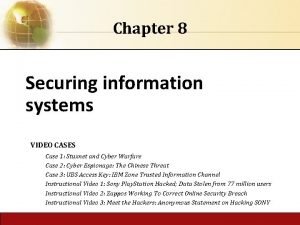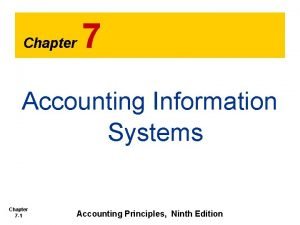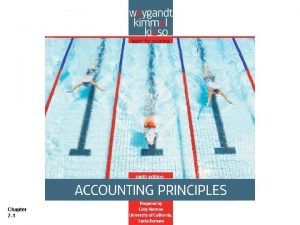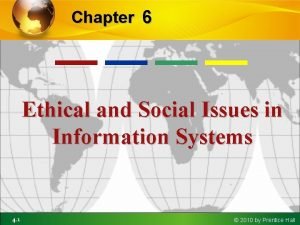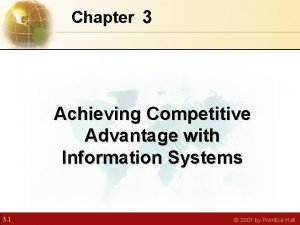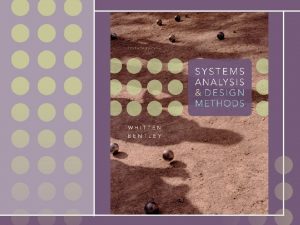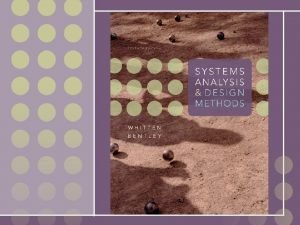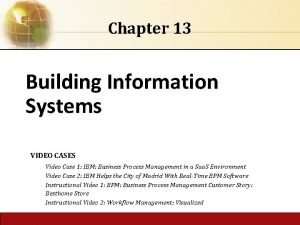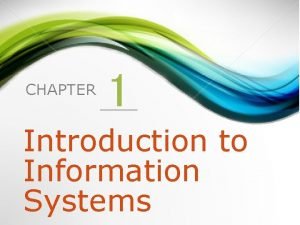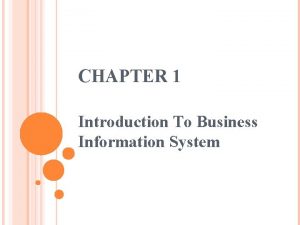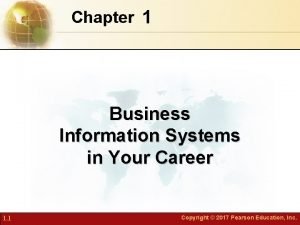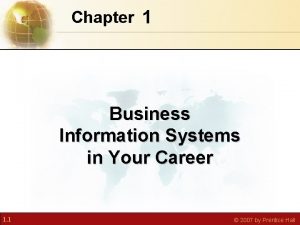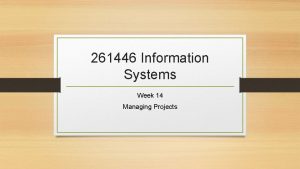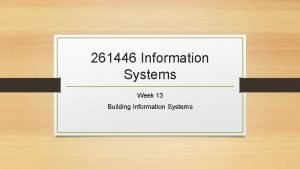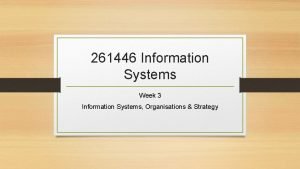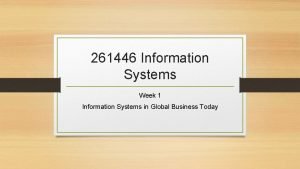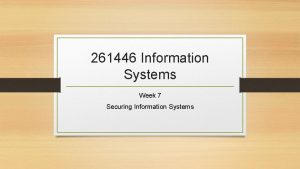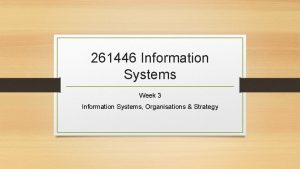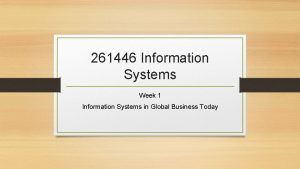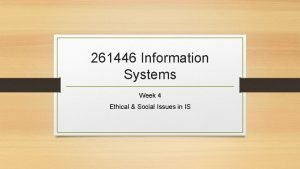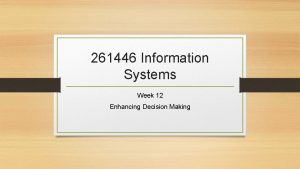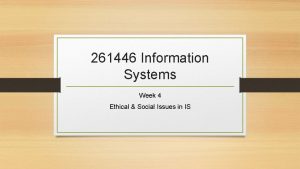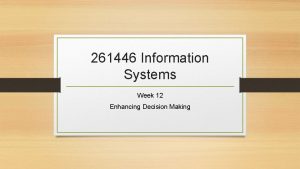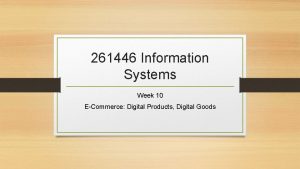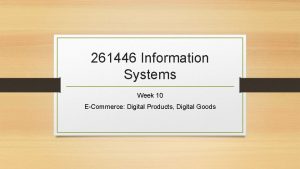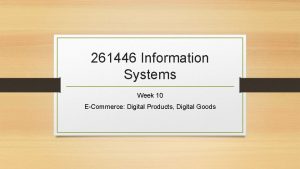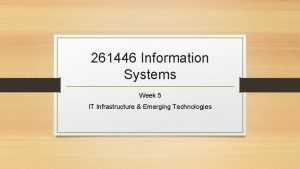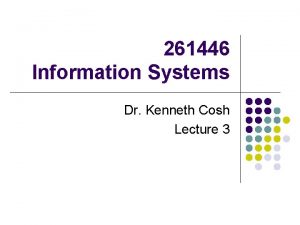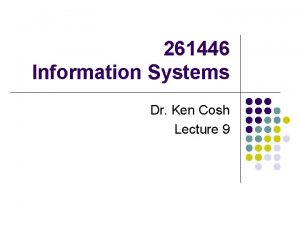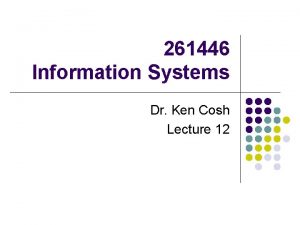261446 Information Systems Week 11 Managing Knowledge Week















































































- Slides: 79

261446 Information Systems Week 11 Managing Knowledge

Week 11 Topics • • The Knowledge Management Landscape Enterprise-Wide Knowledge Management Systems Knowledge Work Systems Intelligent Techniques

Case Studies • Case Study #1) Designing Drugs Virtually • Case Study #2) Knowledge Management and Collaboration at Tata Consulting Services

Knowledge Management • Useful Knowledge can be communicated and shared • Knowledge Management is concerned with capturing useful and actionable Knowledge to share throughout an organization

Ackoff’s Pyramid

Knowledge • Tacit & Explicit • Knowledge is an event that takes place inside people’s heads. • It’s stored in libraries, records, shared in lectures, emails, graphics, structured and unstructured documents. • Tacit • Knowledge that resides in the minds of employees • Explicit • Knowledge that has been documented

Knowledge is an Asset • But a different kind of asset to other firm assets • It is intangible • Transforming data into information and then knowledge takes resources • Knowledge isn’t subject to the law of diminishing returns… - instead, unlike physical assets, network effects can increase it’s value as it is shared

Knowledge is an Asset • Knowledge has different forms • Tacit or Explicit • Knowing how, why and when to follow procedures • Knowing when to apply a procedure is as important as knowing the procedure

Organisational Learning • A process of creating and gathering knowledge • • • Data collection Measurement of planned activities Trial and error Feedback from customers Feedback from environment

Knowledge Management Value Chain • 5 Key Stages • • • Data & Information Acquisition Acquire Store Disseminate Apply


Knowledge Acquisition • Early KMS involved building repositories of documents, reports, presentations, & best practices. • Extended to include unstructured knowledge such as E-mails. • Developing networks so “the expert” can easily be found • Finding patterns in corporate data.

Knowledge Storage • Once discovered, documents, patterns & expert rules must be stored • A database? • How do we digitize and index knowledge documents, and encourage / reward employees for taking the time to update and store documents correctly? • For example: - The sales force need to submit names and contacts of prospects so all sales personnel can identify each prospect and review stored knowledge

Knowledge Dissemination • Great technological tools for disseminating knowledge; • Portals, email, messaging, wikis, social networks.

Knowledge Management Systems

EXPERTS & EXPERT SYSTEMS • Domain Experts • People who know about a domain – we are experts in the University domain. • Rule representation • We represent what we know about a domain in a set of rules that govern the domain; • If XXX then YYY • Rules can be Relations, Recommendations, Directives, Strategies or Heuristics.

CREATING AN EXPERT SYSTEM • 5 key roles; • • • Project Manager Domain Expert Knowledge Engineer Programmer End User

DOMAIN EXPERT • A knowledgeable and skilled person capable of solving problems in the specified domain, having the greatest expertise in that domain. This expertise will be captured by the expert system, so they must be able to communicate their knowledge and participate in expert system development. This is the most important role.

KNOWLEDGE ENGINEER • Someone capable of designing building and testing an expert system. They begin by interviewing the expert to find out how to solve a particular problem. The knowledge engineer is responsible for capturing what reasoning methods are used to handle facts and rules, and then decide how to represent it in the system.

THE REST • Programmer • Responsible for coding the domain knowledge. • Project Manager • Responsible for keeping the project on track. • End User • The people who are going to use the system once its complete.

PRODUCTION RULES • Newell and Simon from CMU, developed the production rule system in the early 70’s. • Basically humans solve problems by applying their knowledge (or production rules) to specific problem information. • Production rules are stored in long term memory, and problem specific information is stored in short term memory.

SYSTEM MODEL

RULE BASED EXPERT SYSTEM

EXPERT SYSTEM • The knowledge base contains the domain knowledge useful for problem solving – represented as rules; • Relations, Recommendations, Directives, Strategy, Heuristic. • When the conditions of a rule are satisfied then the action part is executed. • The database contains the facts which can be matched against the conditions.

EXPERT SYSTEM • The inference engine performs this reasoning, as we shall see, to reach as solution, linking rules to facts. • The explanation facilities crucially explain how the expert system reached its conclusions, to justify its advice. • The user interface is, well a user interface!

EXPERT SYSTEM EFFICIENCY • Expert Systems are designed to perform in the same way as an expert, therefore the primary concern is accuracy – it doesn’t matter how fast the system comes up with a wrong answer! • However, in many cases speed of reaching a solution is important – accurate decisions are not that useful if it is too late to apply the decisions.

CAN THEY BE WRONG? • Of course • Human Experts are sometimes wrong, and yet we still trust them! • Likewise, the expert systems solutions may be wrong, but should we trust it?

EXPERT COMPARISON

EXPERT COMPARISON 2

CHAINING • Often the action part of a rule, creates a new fact to add to the database; • If X is good, then Y is bad. • This would add ‘Y is bad’ to the facts in the database. • This matching can create inference chains, which illustrates how a conclusion is reached.

INFERENCE CYCLES

INFERENCE CHAIN

FORWARD CHAINING • Or, “Data Driven Reasoning”. • This is where we start from known data and proceed forward. When a rule is fired new info is added to the database, until no further rules can be fired.

FORWARD CHAINING

FORWARD CHAINING • Technique for gathering information and inferring whatever can be inferred from it. • In forward chaining many rules are executed which may have nothing to do with the goal. • So if the goal is to infer a particular fact, forward chaining is inefficient.

BACKWARD CHAINING • Or “Goal Driven Reasoning” • The expert system begins with a goal, and the expert system attempts to find the evidence to prove it. • First the knowledge base is searched to find rules that might have the desired solution (the then part), and then rules that can start those are searched for, with each rule being added to a stack.

BACKWARD CHAINING

FORWARDS OR BACKWARDS? • Which is best? • Consider if trying to find the murderer on CSI? • or the disease on House? • or deciding strategy on Survivor?

CONFLICT RESOLUTION • What happens when rules contradict each other? • Highest Priority first? • Assuming rules can be placed in priority. • Most Specific Rule? • The longest matching strategy, a specific rule processes more information than a general one, so one with more antecedents is likely to be more useful. • Most Recent Rule? • The rule which has been fired most recently, i. e. whose antecedent uses the most recently added data.

METAKNOWLEDGE • Deciding which strategy to use is stored in the metaknowledge – knowledge about knowledge. • And the rule is a metarule. • Rules supplied by experts have higher priority than those from novices. • Rules governing the rescue of human life have highest priority.

EXPERT SYSTEMS ADVANTAGES • Natural Knowledge Representation • Everything is stored in easy to read and understand natural language. • Uniform Structure • The syntax can be used in many different situations. • Knowledge / Processing Separation • Knowledge is separated from the inference engine, so different systems can be developed from the same knowledge. • Incomplete and uncertain knowledge • Can easily be dealt with by an expert system.

EXPERT SYSTEMS DISADVANTAGES • Opaque relations between rules. • It is difficult to see how individual rules affect the whole system. • Ineffective searching • Searches are exhaustive – looking through all rules everytime, which can make it slow. • Learning • Expert systems can not learn, they can’t decide when to break the rules, or when to add a rule or modify one, as a human expert could.

FUZZY LOGIC • Let’s consider getting a bit fuzzier! • An expert might say; • “The Power transformer is slightly overloaded, but I can keep this load for a while. ” • Experts have no trouble understanding this, but how can an expert system deal with such vagueness? • Such ‘Fuzziness’?

FUZZY LOGIC • Fuzzy Logic is NOT Logic that is Fuzzy, but logic used to describe the fuzziness. • Fuzzy Logic is theory of sets to calibrate vagueness. • Fuzzy Logic is based on the idea that all things have degrees; • Temperature, Height, Speed, Distance, ‘Chairness’ • When does a hill become a mountain?

TRADITION • Boolean (conventional) logic enforces sharp distinctions, things are either a member of a set, or a non member. • Either 0 or 1. • Tom is tall, at 181 cm, while Tim is small at 179 cm. • But this is due to an arbitrary line drawn in the sand at 180 cm.

POSSIBILITY THEORY • A man who is 181 cm is ‘possibly’ tall, perhaps we could say with 0. 86% possibility? • i. e. it is likely that he is tall. • Lukasiewicz, a Polish philosopher, produced work in 1930 which led to this inexact reasoning, or possibility theory.

MAX BLACK (1937) • A long line of chairs. • At one end is a Chippendale. • Next to it is a near Chippendale, so near to being a Chippendale that it is indistinguishable from a Chippendale. • And so on with chairs becoming slightly less chairlike, until at the other end there is a log. • When does a chair become a log? • Well, the % of people who would call each element a chair!

COMPARISON 0 0 Boolean Logic 1 1 0 0. 2 0. 4 0. 6 Fuzzy Logic 0. 8 1

ZADEH 1965 • “Fuzzy Logic is determined as a set of mathematical principles for knowledge representation based on degrees of membership rather than on crisp membership of classical binary logic” • Lofti Zadeh is Master of fuzzy logic.

PYTHAGORAS 400 BC • Q: Does the Cretan philosopher tell the truth when he asserts that ‘All Cretan’s lie’? • Boolean Logic: Contradiction! • Fuzzy Logic: The philosopher does and does not tell the truth.

RUSSELL’S PARADOX • The barber of a village gives a hair cut only to those who do not cut their hair themselves. Who cuts the barber’s hair? • Boolean: Contradiction! • Fuzzy Logic: The barber cuts and doesn’t cut his own hair!

MEMBERSHIP OF THE TALL MEN SET Name Height Degree of Membership Crisp Fuzzy Chris 208 1 1. 00 Mark 205 1 1. 00 John 198 1 0. 98 Tom 181 1 0. 82 David 179 0 0. 78 Mike 172 0 0. 24 Bob 167 0 0. 15 Steven 158 0 0. 06 Bill 155 0 0. 01 Peter 152 0 0. 00

TALL MEN Degree of Membership 1. 0 0. 8 0. 6 0. 4 0. 2 0. 0 150 160 170 180 190 200 210 Height (cm) 1. 0 0. 8 0. 6 0. 4 0. 2 0. 0 Height (cm)

SHORT, AVERAGE AND TALL Degree of Membership 1. 0 0. 8 0. 6 0. 4 0. 2 0. 0 Short 150 Average 160 170 Tall 180 Height (cm) 190 200 210

LINGUISTIC QUALIFIERS • Language carries with it a set of modifiers which can change the shape of a fuzzy set; • for instance what is the relationship between ‘tall’ and ‘very tall’? • Some perform ‘concentration’, such as ‘very’ • some perform ‘dilation’, such as ‘more or less’ • The set of very tall men is different from the set of more or less tall men. • How about the difference between the set of slightly hot and the set of moderately hot?

GRAPHICAL REPRESENTATION Short Degree of Membership 1. 0 0. 8 0. 6 0. 4 0. 2 0. 0 Average Tall Very Short 150 Very Tall 160 170 180 Height (cm) 190 200 210

‘VERY’ • So how much is ‘very’? What is the power of the concentration? • How about a square; • i. e. if Tom has a 0. 86 membership of the set ‘tall men’, then he has a 0. 86*0. 86 = 0. 7396 membership of the set ‘very tall men’. • Similarly he has 0. 864 = 0. 547 membership of the set ‘very, very tall men’. • We can assign the power 3 to ‘extremely’ meaning that Tom has 0. 863 = 0. 6361 membership of the set ‘extremely tall men’.

DILATION • Similarly the dilation modifiers can be made into an equation; • ‘More or Less’ is given the formula √, i. e. Tom has √ 0. 86 = 0. 9274 membership of the set ‘more or less tall men’.

CANTOR’S SETS • Cantor proposed several operations on traditional sets, but how do they translate to fuzzy sets? A Not A A Complement Intersection A B B A B Containment Union

COMPLEMENT • Who does not belong to the set? • The complement of a set is the opposite of a set. So if we have a set of tall men, the complement is not tall men. • With fuzzy logic, if Tom has 0. 86 membership of ‘tall men’, then he has 0. 14 membership of ‘not tall men’.

CONTAINMENT • Which set belongs to other sets? • Well, ‘very tall men’ is a subset of ‘tall men’, which in turn is a subset of ‘men’. • With fuzzy logic, membership values can change for different sets and subsets.

INTERSECTION • Which elements belong to both sets? • We’ve already seen how a man can be a member of ‘tall men’ and ‘average men’, simply by having a membership value for both sets.

UNION • Which elements belong to either set? • Tom belongs to the tall set, so he belongs to the tall or fat set! • So, crisp and fuzzy sets hold the same properties, in fact crisp sets can be considered a special case of fuzzy sets.

MORE GENERAL SET RULES • Commutativity • • A B=B A • Associativity • • A (B C)=(A B) C • Distributivity • • A (B C)=(A B) (A C) • Idempotency • • A A=A

MORE GENERAL SET RULES • Identity • • A undefined = A A unknown = A A undefined = undefined A unknown = unknown • Involution • ¬(¬A) = A • Transitivity • If (A ∋B) (B ∋C) then (A ∋C) • De Morgan’s Laws • • ¬(A B) = ¬A ¬B

GENERAL SET RULES • The general set rules apply equally to fuzzy sets. • The key difference is in degree of membership, while entities are either members or not members for normal sets, they have degrees of membership for fuzzy sets. • Set of Prime numbers : 5, 13 etc. • Fuzzy set of tall men : degrees of membership.

FUZZY RULES • If x is A, then y is B. • Where x and y are variables, and A and B are values determined by fuzzy sets. • If Speed is >100, Then stopping_distance is long. • If Speed is <40, Then stopping_distance is short.

FUZZIER • If Speed is Fast, then Stopping_Distance is Long. • If Speed is Slow, then Stopping_Distance is Short. • Here perhaps speed has a numerical range 0 -220 kmph, and Stopping_Distance has a numerical range 0 -300 m, but each has been broken into fuzzy sets (fast/slow) and (long/medium/short).

REASONING • In classical reasoning, if an antecedent is true, then the consequent is true, but with fuzzy sets; • The degree of membership in the antecedent set influences the degree of membership in the consequent set.

INFERENCE • If Height is Tall, Then Weight is Heavy. • From this we can estimate a mans weight dependent on their height. degree of membership 1 1 0 0 160 180 200 220 240 height 70 80 90 100 110 120 weight

HOW ABOUT THESE? • If Service is Excellent, OR Food is Delicious, then Tip is Generous. • If Project_Duration is Long AND Project_Staff is Large AND Project_Fund is Inadequate, then Risk is High. • If Temperature is Hot, then Hot_Water is Reduced (AND/OR) Cold_Water is Increased. • All of these rules are possible, with a bit more work!

MAMDANI INFERENCE • A simple example; • 2 Inputs • Project_Funding (Fuzzified from crisp percentage input to inadequate, marginal and adequate) • Project_Staffing (Fuzzified from crisp percentage input to small and large) • 1 Output • Risk (high, normal or low)

EXAMPLE’S RULES • 3 Rules • If Project_Funding is Adequate, OR Project_Staffing is Small, Then Risk is Low. • If Project_Funding is Marginal AND Project Staffing is Large, Then Risk is Normal. • If Project_Funding is Inadequate, Then Risk is High.

MAMDANI INFERENCE • 4 Steps • • 1) Fuzzification 2) Rule Evaluation 3) Aggregation of Rule Outputs 4) Defuzzification

FUZZIFICATION • Take crisp inputs and determine their fuzzy set memberships. • Normally requires expert judgement. • For Example; • Project_Funding at 35% has 0. 5 membership of inadequate and 0. 2 membership of marginal. • Project_Staffing at 60% has 0. 1 membership of small and 0. 7 membership of large.

RULE EVALUATION • The next step is to apply fuzzy inputs to the rule antecedents. • Rule 1: If Project_Funding is Adequate, OR Project_Staffing is Small, Then Risk is Low. • P_F is 0 Adequate • P_S is 0. 1 Small • Risk is 0. 1 Low.

RULE EVALUATION • Rule 2: If Project_Funding is Marginal AND Project Staffing is Large, Then Risk is Normal. • P_F is 0. 2 Marginal • P_S is 0. 7 Large There is a choice of ways to apply this, but we choose ‘min’. • Risk is 0. 2 Normal. • Rule 3: If Project_Funding is Inadequate, Then Risk is High. • P_F is 0. 5 Inadequate • Risk is 0. 5 High.

AGGREGATION OF RULE OUTPUTS • Summary • Risk is 0. 1 Low. • Risk is 0. 2 Normal. • Risk is 0. 5 High. Risk Low 0 10 High Normal 20 30 40 50 60 70 80 90 100

DEFUZZIFICATION • Calculate the Centre of Gravity. Risk 0 10 20 30 40 50 60 70 80 90 • ((0+10+20)*0. 1+(30+40+50+60)*0. 2+(70+80+90+100)*0. 5)/0. 1+0. 2+0. 5+0. 5 = 67. 4 • So the project risk is a member of high and normal, but a bigger member of high. 100
 Managing and using information systems
Managing and using information systems Management information systems managing the digital firm
Management information systems managing the digital firm Information
Information Managing knowledge in the digital firm
Managing knowledge in the digital firm Improving decision making and managing knowledge
Improving decision making and managing knowledge Week by week plans for documenting children's development
Week by week plans for documenting children's development Managing global systems chapter 15
Managing global systems chapter 15 Global systems 1 management
Global systems 1 management Managing global systems
Managing global systems Personal vs shared knowledge
Personal vs shared knowledge Knowledge shared is knowledge squared
Knowledge shared is knowledge squared Knowledge shared is knowledge multiplied interpretation
Knowledge shared is knowledge multiplied interpretation Knowledge creation and knowledge architecture
Knowledge creation and knowledge architecture Contoh shallow knowledge dan deep knowledge
Contoh shallow knowledge dan deep knowledge A priori knowledge
A priori knowledge Street knowledge vs book knowledge
Street knowledge vs book knowledge Knowledge claim
Knowledge claim Gertler econ
Gertler econ Despite the data glut that marketing managers
Despite the data glut that marketing managers Arrangements for managing information between professionals
Arrangements for managing information between professionals Managing information technology resources
Managing information technology resources Management information system managing the digital firm
Management information system managing the digital firm A good mis balances the information users would
A good mis balances the information users would Managing marketing information
Managing marketing information Embedded systems week
Embedded systems week Indigenous knowledge systems tok
Indigenous knowledge systems tok Knowledge sharing systems
Knowledge sharing systems Knowledge capture systems
Knowledge capture systems What are knowledge sharing systems
What are knowledge sharing systems Knowledge work systems kws definition
Knowledge work systems kws definition Knowledge management systems
Knowledge management systems Knowledge management systems
Knowledge management systems Knowledge management in healthcare
Knowledge management in healthcare Difference between data and information
Difference between data and information People in media and people as media differences
People in media and people as media differences Data information knowledge action
Data information knowledge action Enterprise information technology knowledge
Enterprise information technology knowledge Starving for knowledge
Starving for knowledge Decision support systems and intelligent systems
Decision support systems and intelligent systems Engineering elegant systems: theory of systems engineering
Engineering elegant systems: theory of systems engineering Embedded systems vs cyber physical systems
Embedded systems vs cyber physical systems Elegant systems
Elegant systems User acceptance of hedonic information systems
User acceptance of hedonic information systems Tactical marketing information systems
Tactical marketing information systems Securing information systems
Securing information systems Retail information systems houston
Retail information systems houston Principles of information systems, seventh edition
Principles of information systems, seventh edition Management information system topics
Management information system topics Function of information system with diagram
Function of information system with diagram What is management information systems
What is management information systems Ups information systems
Ups information systems Definition of mis
Definition of mis Survival in information system
Survival in information system Introduction to information systems 6th edition
Introduction to information systems 6th edition Fundamentals of information systems 9th edition
Fundamentals of information systems 9th edition Fundamentals of information systems 9th edition
Fundamentals of information systems 9th edition Functional system in business
Functional system in business Ethical issues in information systems
Ethical issues in information systems Voyage estimating decision support system
Voyage estimating decision support system Communication technology quiz
Communication technology quiz Clinical and administrative health information system
Clinical and administrative health information system Is strategy triangle
Is strategy triangle Global challenges in information systems
Global challenges in information systems Social media information system
Social media information system Securing information systems
Securing information systems Chapter 8 securing information systems
Chapter 8 securing information systems Chapter 8 securing information systems
Chapter 8 securing information systems Chapter 7 accounting information systems
Chapter 7 accounting information systems Chapter 7 accounting information systems
Chapter 7 accounting information systems Ethical and social issues in information system
Ethical and social issues in information system Achieving competitive advantage with information systems
Achieving competitive advantage with information systems Information systems building blocks
Information systems building blocks Building blocks of an information system
Building blocks of an information system Collaboration information systems
Collaboration information systems Redesigning the organization with information systems
Redesigning the organization with information systems Chapter 13 building information systems
Chapter 13 building information systems You should seek to be an informed user of it because
You should seek to be an informed user of it because Components of information systems
Components of information systems How will information systems affect business careers
How will information systems affect business careers How will information systems affect business careers
How will information systems affect business careers
